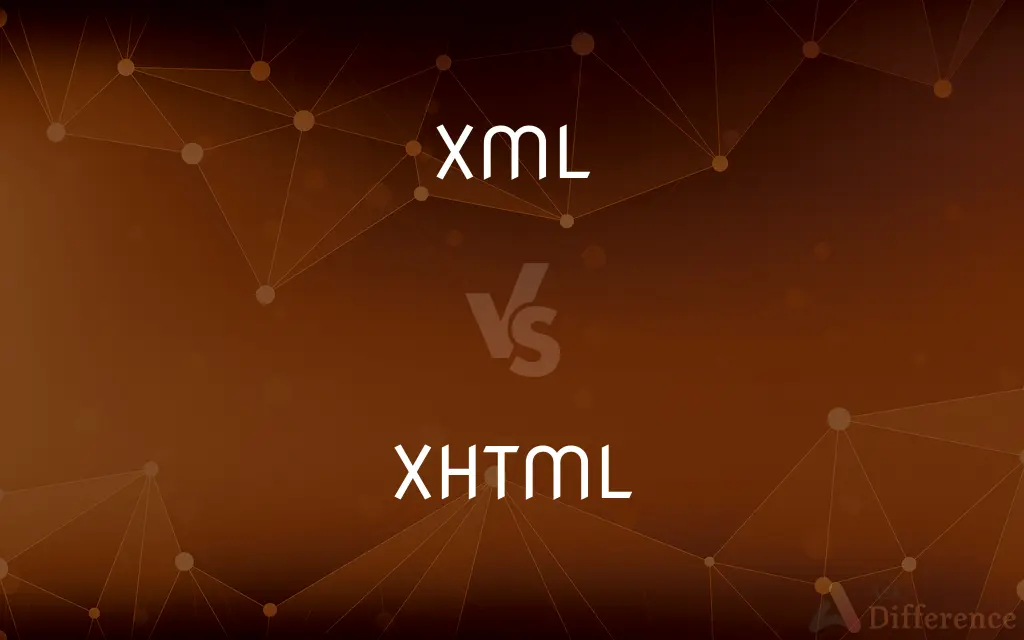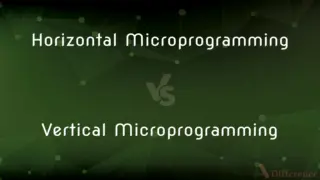XML vs. XHTML — What's the Difference?
By Tayyaba Rehman — Published on January 28, 2024
XML (eXtensible Markup Language) is a flexible data format for structured document exchange, while XHTML (eXtensible HyperText Markup Language) is a strict, XML-based version of HTML.

Difference Between XML and XHTML
Table of Contents
ADVERTISEMENT
Key Differences
XML is a markup language designed for storing and transporting data, offering a flexible way to create information formats and electronically share structured data. XHTML, on the other hand, is a reformulation of HTML as an XML application, designed to standardize HTML with more rigorous syntax rules.
XML is not limited to web pages and is used broadly for data representation in various applications, such as web services, configuration files, and data interchange. XHTML is specifically aimed at web documents, ensuring that HTML documents are well-formed and adhere to XML standards.
XML allows custom tag creation, enabling users to define their own tags according to their data needs. XHTML uses a predefined set of tags, similar to HTML, but with stricter syntax rules derived from XML, ensuring that documents are correctly structured and parsed by XML parsers.
In terms of syntax, XML is more lenient compared to XHTML. While XML emphasizes data structure and transport, XHTML focuses on presentation and strict syntax conformity, requiring tags to be properly closed and nested.
XML is widely used in data exchange and API integrations due to its versatility and simplicity. XHTML, while less commonly used than HTML5 in modern web development, ensures compatibility and consistency across different browsers and platforms by adhering to XML rules.
ADVERTISEMENT
Comparison Chart
Primary Use
Data storage and transport
Web documents
Flexibility
Custom tag creation allowed
Fixed, predefined tag set
Syntax Rules
Lenient, focus on data structure
Strict, conforming to XML standards
Application Scope
Broad, beyond web documents
Focused on web document standards
Tag Rules
Tags are flexible
Strict tag closing and nesting
Compare with Definitions
XML
A flexible markup language for structured data exchange.
We use XML to store and transport data between systems.
XHTML
Aims at standardizing HTML with XML syntax.
XHTML combines the flexibility of HTML with the strictness of XML.
XML
Widely used in web services and data interchange.
Our web service APIs exchange information using XML.
XHTML
Ensures compatibility across browsers and platforms.
Using XHTML improves our website's compatibility with different browsers.
XML
Allows custom tag creation for various data needs.
XML's custom tags make it easy to structure our product data.
XHTML
A stricter version of HTML based on XML standards.
We converted our web pages to XHTML for better syntax consistency.
XML
Emphasizes data structure and transport.
XML is ideal for representing complex data structures.
XHTML
Uses a predefined set of tags with strict rules.
In XHTML, all tags must be properly closed and nested.
XML
Lenient in syntax compared to XHTML.
XML offers more flexibility in tag syntax than XHTML.
XHTML
Ensures well-structured and parsable web documents.
XHTML helps in creating web pages that are easily parsed by XML parsers.
XML
An international standard metalanguage for creating markup languages that structure digital information in a way that allows for the exchange, display, and storage of data independent of proprietary operating systems and hardware devices.
Common Curiosities
Is XML still relevant in modern programming?
Yes, it's widely used in data exchange, web services, and configuration files.
Can XHTML be used for applications other than web pages?
XHTML is primarily used for web documents, not for general applications like XML.
Is XML a programming language?
No, it's a markup language used for structuring and transporting data.
Is debugging easier in XML or XHTML?
Debugging can be easier in XML due to its lenient syntax.
How strict is XHTML compared to HTML?
XHTML is stricter, requiring well-formed code that adheres to XML standards.
Can XML be used for storing large amounts of data?
Yes, XML is suitable for storing and structuring large data sets.
Why is XHTML less popular than HTML5?
XHTML's strict syntax rules make it less flexible compared to HTML5.
Is XML easy to learn for beginners?
Yes, its straightforward syntax makes it accessible for beginners.
How does XML handle character encoding?
XML supports various character encodings, including UTF-8.
Are XHTML documents compatible with all browsers?
XHTML documents, if properly coded, are widely compatible with modern browsers.
Is XHTML a good choice for responsive web design?
XHTML can be used for responsive design, but HTML5 is often preferred.
Can XML be used for API development?
Yes, it's commonly used in API development for data exchange.
Can I convert HTML documents to XHTML?
Yes, HTML documents can be converted to XHTML by following stricter syntax rules.
Can XHTML improve SEO?
Well-structured XHTML code can aid in SEO, but it's not a primary factor.
Is XML suitable for data visualization?
While XML can structure data for visualization, it's not used for visualization itself.
Share Your Discovery

Previous Comparison
Horizontal Microprogramming vs. Vertical Microprogramming
Next Comparison
14 SEER vs. 13 SEERAuthor Spotlight
Written by
Tayyaba RehmanTayyaba Rehman is a distinguished writer, currently serving as a primary contributor to askdifference.com. As a researcher in semantics and etymology, Tayyaba's passion for the complexity of languages and their distinctions has found a perfect home on the platform. Tayyaba delves into the intricacies of language, distinguishing between commonly confused words and phrases, thereby providing clarity for readers worldwide.
















































